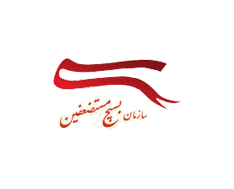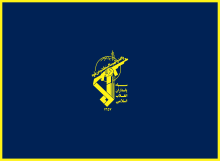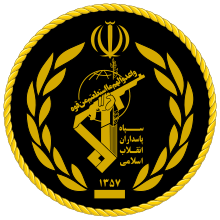Basij
The Basij (Persian: بسيج, lit. "The Mobilization"), Niru-ye Moghāvemat-e Basij (Persian: نیروی مقاومت بسیج, "Mobilisation Resistance Force"), full name Sāzmān-e Basij-e Mostaz'afin (Persian: سازمان بسیج مستضعفین, "The Organization for Mobilization of the Oppressed"),[4][5] is one of the five forces of the Islamic Revolutionary Guard Corps.[6] A paramilitary volunteer militia established in Iran in 1979 by order of Ayatollah Khomeini, leader of the Iranian Revolution, the organization originally consisted of civilian volunteers who were urged by Khomeini to fight in the Iran–Iraq War.[7]
 | |
 | |
| Formation | 26 November 1979 (decreed)[1] 30 April 1980 (founded)[1] |
|---|---|
| Founder | Ruhollah Khomeini[1] |
| Type | Paramilitary volunteer militia[1] |
| Purpose | Auxiliaries[1] |
| Fields | Internal security, law enforcement, moral policing[1] |
Commander | Brig. Gen. Gholamreza Soleimani |
Parent organization | None (1980–81) Islamic Revolutionary Guard Corps (since 1981) |
Budget (1395 SH) | |
Staff (2005) | 90,000 (CSIS estimate)[1] |
Volunteers (2009) | 11.2 million (official data)[1] 600,000 available for mission[3] |
| Website | basij |
It was an independent organization from inception until 17 February 1981, when it was officially incorporated into the Revolutionary Guards organization structure by the Iranian Parliament[8] in order to end the interservice rivalry between the two, according to Akbar Hashemi Rafsanjani.[1]
Today the force consists of young Iranians who volunteer, often in exchange for official benefits. Basij serve as an auxiliary force engaged in activities such as internal security, enforcing state control over society,[9] law enforcement auxiliary, providing social services, organizing public religious ceremonies, policing morals, and suppression of dissident gatherings.[10][11] The force is named Basij; an individual member is called basiji.[12]
The Basij are subordinate to and receive their orders from the Islamic Revolutionary Guard Corps (IRGC) and the Supreme Leader of Iran, to whom they are known for their loyalty.[13][14] They have a local organization in almost every city in Iran.[15]
As of July 2019 Gholamreza Soleimani is the commander of the Basij.[16][17] The force was often present and reacting to the widespread 2009 Iranian election protests and 2017–18 Iranian protests.[18]
Basij, being part of the IRGC, is designated as a terrorist organization by the governments of the United States, Bahrain and Saudi Arabia.[19]
History
Supreme Leader Ayatollah Ruhollah Khomeini called for the foundation of a youth militia in November 1979, during the Iranian Revolution.[4] The Basij was established on 30 April 1980.[12] It was open to those above the age of 18 and below the age of 45.
During the Iran–Iraq War hundreds of thousands volunteered for the Basij, including children as young as 12 and unemployed old men, some in their eighties. These volunteers were swept up in Shi'a love of martyrdom and the atmosphere of patriotism of the war mobilization; most often they came from poor, peasant backgrounds. They were encouraged through visits to schools and an intensive media campaign. During the war, the Revolutionary Guard Corps used Basiji members as a pool from which to draw manpower.[20] The Basij may best be known for their employment of human wave attacks which cleared minefields or drew the enemy's fire.[21] It is estimated that tens of thousands were killed through the use of this tactic.
The typical human wave tactic was for Basijis (often very lightly armed and unsupported by artillery or air power) to march forward in straight rows. While casualties were high, the tactic often worked when employed against poorly trained members of the Iraqi regular army.[22][23]
According to Dilip Hiro, by the spring of 1983 the Basij had trained 2.4 million Iranians in the use of arms and sent 450,000 to the front.[24] In 1985 the IRNA put the number of Basijis at 3 million, quoting from Hojjatoleslam Rahmani.[4] Tehran Bureau estimates the peak number of Basijis at the front at 100,000 by December 1986.[12]
| Islamic Revolutionary Guard Corps |
|---|
 |
| Command |
|
Supreme Leader of Iran Commanders |
| Military branches |
|
Ground Forces Aerospace Force Navy Quds Force Basij |
| Intelligence agencies |
|
Intelligence Organization Intelligence Protection Organization |
| Personnel |
| Ranks insignia |
| Facilities |
|
Imam Hossein University Baqiyatallah University University of Command and Staff |
Revival
According to The New York Times, after the spontaneous celebrations following Iran winning a spot in the 1998 FIFA World Cup, and the student protests in July 1999, the Islamic government felt that it had lost control of the streets, and reactivated the Basij.[13] Giving a slightly different timeline, GlobalSecurity.org reports that it was revived around 2005.[25]
The Iranian Government has drawn up a number of different plans to keep the Basij alive. Among these plans is the emphasis on ideas such as Development Basij (Basij-e-Sazandegi).[25] Along with the Iranian riot police and the Ansar-e-Hezbollah, the Basij have been active in suppressing student demonstrations in Iran. The Basij are sometimes differentiated from the Ansar in being more "disciplined" and not beating, or at least not being as quick to beat demonstrators.[26] Other sources describe the Ansar-e-Hezbollah as part of the Basij.[13]
Some believe the change in focus of the Basij from its original mission of fighting to defend Iran in the Iran-Iraq War to its current internal security concerns has led to a loss in its prestige and morale.[27]
2009 election protests
Mir Hussein Moussavi, opposition presidential candidate in 2009, decried violent attacks by the Basij during the 2009 Iranian election protests.[13] There have also been reports of poor performance by Basij after the 2009 election.[12] This was thought to be a reason for the replacement of commander Hossein Taeb and the Basij's formal integration into the Revolutionary Guards ground forces in October 2009.[12] Following the protests, Hojjatoleslam Hossein Taeb, commander of the Basij, stated that eight people were killed and 300 wounded in the violence.[28][29]
In 2010, a Norwegian student doing research in Iran claims he witnessed gruesome atrocities inside a Basij camp after being abducted by the unit while riding on a bus. According to the account the student gave to Norwegian embassy officials, he witnessed detained political dissidents being 'disemboweled', burned to death, and deliberately crushed by a riot control truck.[30]
During the protests, Supreme Leader Ali Khamenei created the Haydaryan, a new paramilitary force specifically dedicated to preserving his position; several of the founding Haydaryan members came from the Basij.[31]
Syrian Civil War, 2011–present
A Western analyst believed thousands of Iranian paramilitary Basij fighters were stationed in Syria as of December 2013.[32] Syria's geopolitical importance to Iran and its role as one of Iran's crucial allies prompted the involvement of Basij militiamen in the ongoing Syrian Civil War. The Basij militia, similar to Hezbollah fighters, work with the Syrian army against rebel forces. Such involvement poses new foreign policy challenges for a number of countries across the region, particularly Israel and Turkey as Iran's influence becomes more than just ideological and monetary on the ground in the Syrian conflict.[33] The Basij involvement in the Syrian Civil War reflects previous uses of the militia as a proxy force for Iranian foreign policy in an effort to assert Iranian dominance in the region[34] and frightens Salim Idriss, head of the Free Syrian Army.[35]
Organization and membership
Basij form the fifth branch of the Islamic Revolutionary Guard Corps. It is organized into the Imam Hossein Brigades and the Imam Ali Brigades (which deal with security threats).[12] Subgroupings of the Basij include the Pupil Basij [Basij-e Danesh-Amouzi], the Student Basij [Basij-e Daneshjouyi], the University Basij, the Public Service Basij (Basij-e Edarii), and the Tribal Basij.[36] Tehran Bureau also lists a "Basij of the Guilds" (Basij-e Asnaf), and a "Labor Basij" (Basij-e Karegaran).[12] Estimates of the number of Basij vary, with its leadership giving higher figures than outside commentators. Official estimates are as high as 23.8 million.[37]
Commanders
The Basij is currently commanded by Gholam-Hossein Gheibparvar, who replaced Mohammad Reza Naqdi in 2016.[36][38] Before Naqdi, Hossein Taeb was appointed commander of the Basij on 14 July 2008.[16][17]
The first deputy commander General Mirahmadi was formally installed on 4 September 2005. The Tehran commander is Seyyed Mohammad Haj Aqamir. The deputy Basij commander for Tehran, General Ahmad Zolqadr, was formally installed on 5 September 2005; the new Basij commander in Tabrizi, Brigadier General Mohammad Yusef Shakeri, assumed office on 29 September 2005.[25]
| Name | Tenure |
|---|---|
| Alireza Afshar | 1990–1998 |
| Mohammad Hejazi | 1998–2007 |
| Hossein Taeb | 2007–2009 |
| Mohammad Reza Naqdi | 2009–2016 |
| Gholamhossein Gheybparvar | 2016–2019 |
| Gholamreza Soleimani | 2019–present |
Duties and activities
According to Radio Liberty, by the end of the war, most of the Basijis left the service and were reintegrated back into their lives, often after years of being in the front.[36] By 1988 the number of Basij checkpoints dramatically decreased,[25] but the Basij were still enforcing the hijab, arresting women for violating the dress code, and arresting youths for attending mixed gender parties or being in public with unrelated members of the opposite sex.[39]
Duties vary by province. Basij are deployed against drug traffickers in the eastern border regions and smugglers in Hormuzgan and Bushehr, and on the border with Iraq.[40]
In 1988 college Basiji organizations were established on college campuses to fight "Westoxification" and potential student agitation against the government.[39]
The Ashura Brigades were created in 1993. These Islamic brigades were made up of both Revolutionary Guards and the Basij and by 1998 numbered 17,000.[4]
According to Golkar,[9] the Basij are used to spread the state's ideology, serve as propaganda machine in political campaigns, justify clerical rule, protect politicians, and enforce Islamic morality and rules. They are part of the Islamic Republic's of Iran's overall avowed plan to have millions of informers. The Basiji also undermine dissent; for instance, they play a key role in suppressing uprisings and demonstrations.[9]
To prepare for war, the Basij are indoctrinated about the benefits of martyrdom.[9]
Benefits and profile of members
Benefits for members of the Basij reportedly include exemption from the 21 months of military service required for Iranian men, reserved spots in universities, and a small stipend.[13] Members of Basij are more likely than non-members to obtain government positions, especially security related positions within government controlled institutions. While some joined the Basij because of genuine religious convictions, others reportedly join Basij only to take advantage of the benefits of membership and to get admission to university or as a tool to get promotion in government jobs.[9][41]
Politics
In theory the Basij are banned from involvement in politics by the Iranian constitution, but its leadership is considered active, particularly during and after the 2005 election of President Mahmoud Ahmadinejad.[12] Supreme Leader Khamenei described Basij as "the greatest hope of the Iranian nation" and "an immaculate tree".[14]
In past elections militia members have voted for both hardliners and reformists. Former President Ahmadinejad enjoyed significant support from militia members, many of whom have benefited from his policies during his presidency.[42]
See also
- List of armed groups in the Syrian Civil War
- Islamic Revolutionary Guard Corps
- Hezbollah of Iran
Notes
- Robin B. Wright, ed. (2010), The Iran Primer: Power, Politics, and U.S. Policy, US Institute of Peace Press, pp. 62–65, ISBN 978-1601270849
- "Iran decreases IRGC budget for next year". AzerNews Newspaper. 18 January 2016. Archived from the original on 23 April 2016. Retrieved 30 March 2016.
- Kenneth Katzman (6 February 2017), "Iran's Foreign and Defense Policies" (PDF), Congressional Research Service, Federation of American Scientists, p. 24, archived (PDF) from the original on 8 March 2017, retrieved 1 March 2017
- John Pike. "GlobalSecurity.org Intelligence: Mobilisation Resistance Force". Archived from the original on 30 April 2011. Retrieved 10 November 2014.
- AEI Outlook Series: What Do Structural Changes in the Revolutionary Guards Mean? Archived 27 October 2011 at the Wayback Machine
- Forozan, Hesam (2015), The Military in Post-Revolutionary Iran: The Evolution and Roles of the Revolutionary Guards, Taylor & Francis, pp. 56–58, ISBN 978-1317430735
- "Basij Militia". The New York Times. 2 December 2011. Archived from the original on 15 May 2013. Retrieved 10 November 2014.
- Alfoneh, Ali (2013), Iran Unveiled: How the Revolutionary Guards Is Transforming Iran from Theocracy into Military Dictatorship, AEI Press, p. 49
- Golkar, Saeid (2015). Captive Society: The Basij Militia and Social Control in Iran. Washington, DC: Woodrow Wilson Center Press. ISBN 978-0-231-80135-5.
- Molavi, Afshin, The Soul of Iran, W. W. Norton, (2005), p. 88, 316–318
- Neil MacFarquhar (19 June 2009). "Shadowy Iranian Vigilantes Vow Bolder Action". The New York Times. Archived from the original on 30 September 2017. Retrieved 19 June 2009.
- iran primer the basij resistance force Archived 17 August 2017 at the Wayback Machine by ALI ALFONEH, pbs.org, 21 October 2010
- Basij Militia. NYT.com Archived 21 August 2009 at the Wayback Machine 19 June 2009
- "Supreme Leader's Speech to Basij Members". Khamenei.ir. 3 May 2008. Archived from the original on 12 November 2013. Retrieved 8 April 2013.
- Molavi, Afshin, The Soul of Iran, W.W. Norton, (2005), p.88
- Hosein Taeb Archived 19 December 2009 at the Wayback Machine Iran Rises. 30 August 2009. accessed 23-September-2009
- "Iran's unfinished crisis. Nazenin Ansari, 16 – 09 – 2009". openDemocracy. Archived from the original on 10 November 2014. Retrieved 10 November 2014.
- "Amnesty urges Iran to stop using Basij militia". The Gazette. 23 June 2009. Retrieved 23 September 2009.
- https://www.reuters.com/article/us-saudi-bahrain-security-iran/saudi-bahrain-add-irans-revolutionary-guards-to-terrorism-lists-idUSKCN1MX288
- Khomeinis Warriors: Foundation of Irans Regime, Its Guardians, Allies around the World, War Analysis, and Strategies by Mehran Riazaty, ISBN 978-1514470336
- Khomeini: Life of the Ayatollah by Baqer Moin
- Cited in: Erich Wiedemann, "Mit dem Paradies-Schlüssel in die Schlacht", in: Der Spiegel, no. 31/1982, p. 93.
- Iran at War: 1500–1988 (Pg. 363) By Kaveh Farrokh
- Hiro, Dilip, Iran under the Ayatollahs, Routledge and Kegan, 1985, p.237
- Iran: Paramilitary Force Prepares For Urban Unrest, September 2005 Archived 8 September 2008 at the Wayback Machine. GlobalSecurity.org.
- Molavi, The Soul of Iran (2005), p. 318
- Scott Peterson. "Iran's angry young adults erupt in political protest 16.6.2003". The Christian Science Monitor. Archived from the original on 10 November 2014. Retrieved 10 November 2014.
- Police, Basij 'imposters' arrested in Iran Archived 2 July 2009 at the Wayback Machine PressTV, 29 June 2009
- Iran opposition says 72 died in post-poll unrest Reuters. 3 September 2009
- SHOCKING ATROCITIES INSIDE A BASIJ ENCAMPMENT: NORWEGIAN EYEWITNESS ACCOUNT (2010 February 9) https://wikileaks.org/plusd/cables/10OSLO67_a.html Archived 8 January 2018 at the Wayback Machine
- "Iran: The Supreme Leader's New Security Force". Archived from the original on 1 September 2017. Retrieved 1 September 2017.
- Iran boosts support to Syria Archived 29 May 2018 at the Wayback Machine, Telegraph, 21 February 2014
- "Iranian Forces on the Golan?". Jerusalem Center For Public Affairs. Archived from the original on 13 August 2013. Retrieved 10 November 2014.
- "The Arab world fears the 'Safavid'". Jerusalem Center For Public Affairs. Archived from the original on 10 November 2014. Retrieved 10 November 2014.
- Gordon, Michael R. (21 May 2013). "Iran and Hezbollah's Support for Syria Complicates U.S. Strategy on Peace Talks". The New York Times. Archived from the original on 7 March 2017. Retrieved 24 February 2017.
- "Iran's Basij Force – The Mainstay Of Domestic Security". Radio Free Europe / Radio Liberty. 15 January 2009. Archived from the original on 10 January 2012. Retrieved 10 November 2014.
- سردار نقدی در برنامه تلویزیونی «متن – حاشیه»:23 میلیون و 800 هزار نفر عضو بسیج هستند/ از کسی تا کنون شکایت نکرده ایم/ رابطه بسیج با این دولت مانند دولت قبل است Archived 23 February 2016 at the Wayback Machine, Fars news agency, November 23, 2015
- "Iran's New Basij Militia Commander More Militaristic Than His Predecessor". Center for Human Rights in Iran. 16 December 2016. Archived from the original on 3 January 2018. Retrieved 2 January 2018.
- Molavi, The Soul of Iran (2005), p. 89
- Iran's Basij Force – The Mainstay Of Domestic Security Archived 10 January 2012 at the Wayback Machine, By Hossein Aryan, RFERL, December 07, 2008
- McDowall, Angus (21 June 2009). "Iran's Basij force: the shock troops terrorising protesters". Daily Telegraph. London. Archived from the original on 29 May 2018. Retrieved 2 April 2018.
- "Profile: Basij militia force". BBC News. 18 June 2009. Archived from the original on 22 June 2009. Retrieved 27 June 2009.
Further reading
- Golkar, Saeid. (2012) Paramilitarization of the Economy: The Case of Iran's Basij Militia, Armed Forces & Society, Vol. 38, No. 4
- Golkar, Saeid. (2015) Captive Society: The Basij Militia and Social Control in Iran. Woodrow Wilson Center Press and Columbia University Press.
External links
- Video Archive of Basij
- Letters from Iran on YouTube – The Basij in the Universities
- "Basij Students Organization official website". Archived from the original on 3 August 2004. Retrieved 2007-04-16.
- "Heavy Weapons for Baseej Volunteer Militia". Archived from the original on 23 April 2006. Retrieved 2006-04-16. from Rooz Online
- Iran Primer: The Basij Resistance Force by ALI ALFONEH, 21 Oct 2010